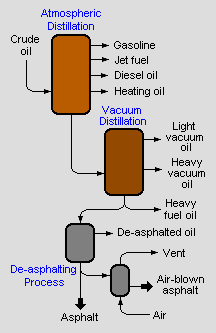User:Milton Beychok/Sandbox
This need a lot of work-over yet before it is a CZ article
Asphalt is a sticky, black and highly viscous liquid or semi-solid that is present in most petroleum crude oils and in some natural deposits. Crude oil is a complex mixture of a great many different hydrocarbons. Petroleum asphalt is defined as that part of crude oil which is separated from the higher-boiling hydrocarbons in crude oil by precipitation upon the addition of lower-boiling hydrocarbon solvents such as propane, pentane, hexane or heptane. The precipitated material consists of asphaltenes which are high molecular weight (800 - 2500 g/mole) compounds that exist in the form of flat sheets of polyaromatic condensed rings with short aliphatic chains.
Petroleum asphalt is sometimes referred to as bitumen, asphaltum, pitch or road-tar. The terminology varies from country to country and from individual to individual. Asphalt is often confused with coal tar (or coal pitch) derived from the pyrolosis of coal and which has a different chemical structure than asphalt.
When petroleum asphalt is combined with construction aggregate (sand, gravel, crushed stone, etc.) for use in road construction, it is often referred to as asphaltic concrete or asphaltic cement (see Asphalt (paving).
The natural deposits of asphalt (often referred to as tar) include asphaltic lakes such as Bermudez Lake in Venezuela, and Pitch Lake in Trinidad. Other natural deposits include tar sands (sometimes called oil sands) and the two largest deposits of tar sands are such as in Alberta, Canada and the Orinoco Oil Belt area of Venezuela.
Production process
Asphalt can be separated from the other components in crude oil (such as naphtha, gasoline and diesel) by the process of fractional distillation, usually under vacuum conditions. A better separation can be achieved by further processing of the heavier fractions of the crude oil in a de-asphalting unit, which uses either propane or butane in a supercritical phase to dissolve the lighter molecules which are then separated. Further processing is possible by "blowing" the product: namely reacting it with oxygen. This makes the product harder and more viscous.
Asphalt is typically stored and transported at temperatures around 300 degrees Fahrenheit (150° C). Sometimes diesel oil or kerosene are mixed in before shipping to retain liquidity; upon delivery, these lighter materials are separated out of the mixture. This mixture is often called bitumen feedstock, or BFS. Some dump trucks route the hot engine exhaust through pipes in the dump body to keep the material warm. The backs of tippers carrying asphalt, as well as some handling equipment, are also commonly sprayed with a releasing agent before filling to aid release. Diesel oil is sometimes used as a release agent, although it can mix with and thereby reduce the quality of the asphalt.
Historical uses
In the ancient Middle East, natural asphalt deposits were used for mortar between bricks and stones, ship caulking, and waterproofing. The Persian word for asphalt is mumiya, which may be related to the English word mummy. Asphalt was also used by ancient Egyptians to embalm mummies.
In the ancient Far East, natural asphalt was slowly boiled to get rid of the higher fractions, leaving a material of higher molecular weight which is thermoplastic and when layered on objects, became quite hard upon cooling. This was used to cover scabbards and other objects that needed water-proofing. Statuettes of household deities were also cast with this type of material in Japan, and probably also in China.
In North America archaeological recovery has indicated that asphaltum was sometimes used to apply stone projectile points to a wooden haft.[1]
During the early-twentieth century when coal was being gasified to produce town gas, the by-product tar was a readily available product. The extensive use of that tar (as a binder for constuction aggregates) in the paving of roads and airports led to the words macadam and tarmac, which are now sometimes used to refer to road making materials. However, since natural gas replaced town gas, petroleum asphalt has completely overtaken the use of coal-derived tar in road and other paving applications.
Current Uses
Road construction
The largest use of petroleum asphalt is for making asphalt concrete for road surfaces and accounts for approximately 80% of the asphalt consumed in the United States.
Roofing shingles
Roofing shingles account for most of the remaining asphalt consumption in the United States.
Other uses of petroleum asphalt
- Asphalt concrete (containing petroleum asphalt as a binder) is widely used for paving vehicle parking lots and aircraft landing and take-off runways in airports around the world
- Canal and reservoir linings as well as dam facings
- Floor tiles
- Battery casings
- Waterproofing of fabrics and various other materials
- Treatment of fence posts and other wooden objects
- Cattle sprays
References
Processing of tar sands
Bibliography
- Barth, Edwin J., Asphalt: Science and Technology Gordon and Breach (1962). ISBN 0-677-00040-5.
